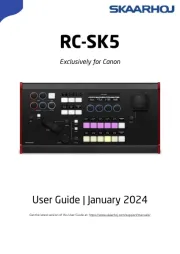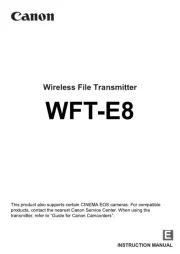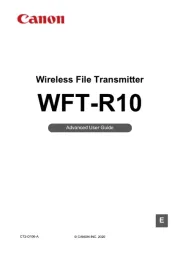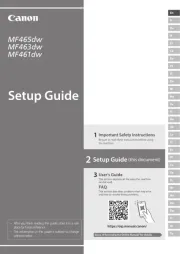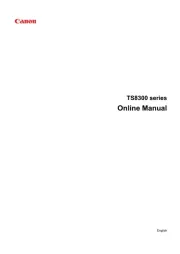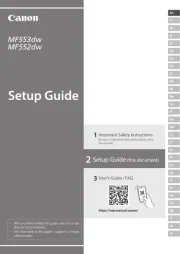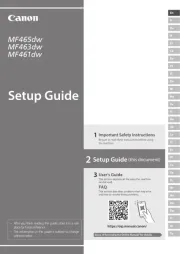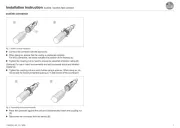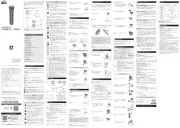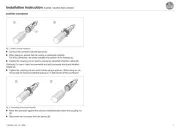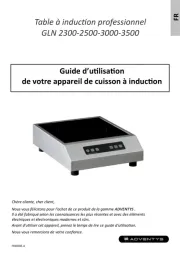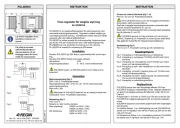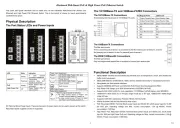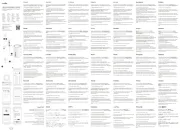The EOS 20Da is a version of the EOS 20D designed for
astrophotography.
Please refer to the EOS 20D Instruction Manual provided for details
of the features common to the cameras.
“Live View” mode enables you to adjust the focus manually while
watching the image live on the LCD monitor. Two modes are available:
FC 1, which provides 5x magnification (approximately 4% of the center
of the image will be displayed on the monitor) and FC 2, which provides
10x magnification (approximately 1% of the center of the image will be
displayed on the monitor).
It may be impossible to have this product repaired outside the
country of purchase.
Die EOS 20Da ist eine Sonderausführung des Modells EOS 20D,
die speziell für die Astrofotografie konzipiert ist.
Die Einzelheiten zu den gemeinsamen Produktmerkmalen beider
Kameramodelle finden Sie in der Bedienungsanleitung der EOS 20D.
Mit dem „Live-Vorschau“-Modus können Sie das Bild manuell scharf
stellen, während Sie es „live“ auf dem LCD-Monitor betrachten. Zwei
verschiedene Modi sind verfügbar: Der FC 1-Modus mit 5-facher
Vergrößerung (ca. 4% der Bildfläche aus dem Bildzentrum werden auf
dem Monitor angezeigt) und der FC 2-Modus mit 10-facher
Vergrößerung (ca. 1% der Bildfläche aus dem Bildzentrum werden auf
dem Monitor angezeigt).
Die Reparatur dieses Produkts außerhalb des Landes, in dem es
gekauft wurde, ist u.U. nicht möglich.
L’EOS 20Da est une version de l’EOS 20D conçue pour
l’astrophotographie.
Pour plus d’informations sur les fonctions communes aux appareils
photo, veuillez consulter le mode d’emploi EOS 20D fourni.
Le mode « aperçu en direct » permet de faire une mise au point
manuelle en regardant l’image en direct sur l’écran LCD. Deux modes
sont disponibles : FC 1, qui permet un agrandissement 5x (environ 4%
de la partie centrale de l’image s’affichera sur l’écran) et FC 2, qui
permet un agrandissement 10x (environ 1% de la partie centrale de
l’image s’affichera sur l’écran).
Il se peut qu’il soit impossible de faire réparer cet appareil à
l’extérieur du pays où il a été acheté.
Focusing Using the LCD Monitor
1Set the Mode Dial to <M>.
2Select either “FC 1” or “FC 2”.
●Set the shutter speed to “buLb” and turn the <6> dial further to
select “FC 1“ or “FC 2“.
3Display the live preview.
●Press the shutter button completely.
The live preview will be displayed on the L
shutter button is depressed completely.
4Adjust the brightness of the live previ
●Let go of the shutter button and set the ap
Then check the live preview again that you
brightness level.
5Manually adjust the focus.
●Looking at the image on the monitor, turn t
the live preview appears sharpest.
E INSTRUCTION MANUAL
Adjusting focus
●The focus should be adjusted within 30 sec
to adjust the focus will increase noise in the
●Focus cannot be adjusted manually in “Live
using the following lenses, which employ ele
focusing:
EF50mm f/1.0L USM, EF85mm f/1.2L USM,
EF200mm f/1.8L USM, EF300mm f/2.8L USM
EF400mm f/2.8L USM, EF400mm f/2.8L ll US
EF500mm f/4.5L USM, EF600mm f/4L USM,
EF1200mm f/5.6L USM, EF28-80mm f/2.8-4
●Remote operation from a computer using EO
is not possible when the camera is set to FC
Using this camera for astrophotograp
●You cannot shoot photographs in FC 1 o
you have adjusted the focus, reset the ap
speed to take a photograph.
●Wait 30 seconds after adjusting the focus be
photograph. Taking a photograph immediate
focus will increase the noise in the image.
●Long exposure times will increase noise. Th
times or less are recommended:
●Sequential shooting will increase the noise
shooting photographs in sequence, you sho
time equivalent to the length of the previous
before taking the next shot.
●Astrophotography mainly employs bulb expo
battery life is diminished. Please ensure tha
with spare batteries. If possible, we recomm
AC Adapter Kit (ACK-E2) supplied with the
At normal temperature, a fully-charged BP-511A battery will
provide 2.5 hours of operation when shooting continuous bulb
exposures.
●When taking long bulb exposures, stray light may enter the
viewfinder and affect the photograph. When you are shooting
without using the viewfinder, the eyepiece cover should be used.
Temperature/ISO 400
20°C/68°F 8 min.
0°C/32°F 16 min.
●The supplied video cable can be connected to the video out
terminal of the camera to enable an external monitor (TV, etc.) to
be used in adjusting the focus. For details, please see “Viewing
the Images on a TV” on p. 110 of the Instruction Manual.
●When the camera is connected to a computer and EOS DIGITAL
software is used, the name of the camera will appear as “EOS
20D” in the window.
Using this camera for regular photography
This camera is approximately 2.5x more sensitive to hydrogen-
alpha light (656 nm) than the EOS 20D. Photographs of normal
subjects that reflect a lot of infra-red light taken with this camera will
therefore appear more red than they actually are. An infra-red
cutoff filter (commercially available) can be used to reduce this
redness.
Scharfstellen mit dem LCD-Monitor
1Stellen Sie das Modus-Wahlrad auf <M>.
2Wählen Sie entweder „FC 1“ oder „FC 2“.
●Stellen Sie die Verschlusszeit auf „ “, und drehen Sie das buLb
Rad <6> weiter, um „FC 1“ oder „FC 2“ auszuwählen.
G BEDIENUNGSANLEITUNG
Wenn Sie mehrere Fotos hintereinander aufnehmen, sollten Sie
zwischen den einzelnen Aufnahmen eine Wartezeit einhalten,
die der Belichtungszeit der vorherigen Aufnahme entspricht.
●Bei der Astrofotografie werden die Fotos vor allem mit
Langzeitbelichtung aufgenommen. Dadurch verringert sich die
Lebensdauer der Akkus. Sorgen Sie dafür, dass Sie immer
Ersatz-Akkus dabei haben. Es wird empfohlen, dass Sie das
mitgelieferte Netzteil ACK-E2 verwenden.
Für Langzeitaufnahmen unter Normaltemperatur reicht ein
vollständig aufgeladener Akku vom Typ BP-511A für ca. 2,5
Stunden Betrieb.
●Bei Langzeitaufnahmen kann Streulicht in den Sucher eindringen
und die Aufnahme beeinträchtigen. Wenn Sie ohne Sucher
fotografieren, verschließen Sie den Sucher mit der
Okularabdeckung.
●Um die Bildschärfe mit Hilfe eines externen Monitors (z.B.
Fernsehgerät) einzustellen, schließen Sie das mitgelieferte
Videokabel am Videoausgang der Kamera und an dem
entsprechenden Anzeigegerät an. Einzelheiten dazu finden Sie
unter „Anzeigen von Bildern auf dem Fernsehbildschirm“
(S. 110) in der Bedienungsanleitung.
●Wenn die Kamera an einem Computer angeschlossen ist und
Sie die EOS DIGITAL-Software verwenden, wird die Kamera in
dem Fenster unter dem Namen „EOS 20D“ angezeigt.
Verwenden der Kamera zum normalen Fotografieren
Diese Kamera ist gegenüber H-Alpha-Licht (656 nm) ca. 2,5-mal
empfindlicher als die EOS 20D. Auf den Fotos, die mit dieser
Kamera aufgenommen werden, erscheinen normale Motive, die
viel Infrarotlicht reflektieren, mit einem Rotstich. Um den Rotstich
zu reduzieren, können Sie einen handelsüblichen Infrarotfilter
verwenden.
Mise au point avec l’écran LCD
1Réglez la molette de sélection des modes sur <M>.
2Sélectionnez « FC 1 » ou « FC 2 ».
●Réglez la vitesse de prise de vue sur « buLb » et tournez encore
la molette <6> pour sélectionner « FC 1 » ou « FC 2 ».
u en direct.
d sur le bouton de prise de vue.
ect s’affichera sur l’écran LCD tant que le bouton
sera maintenu complètement enfoncé.
osité de l’aperçu en direct.
uton de prise de vue et réglez l’ouverture et la
Revérifiez ensuite l’aperçu en direct pour vous
le bon niveau de luminosité.
e au point manuelle.
mage sur l’écran, tournez la bague de mise au
e que l’aperçu en direct s’affiche avec une netteté
F MODE D’EMPLOI
point
doit être effectuée dans les 30 secondes qui
mettez plus de temps à faire la mise au point, le
augmentera.
ible de faire la mise au point manuelle en mode
ct » avec les objectifs suivants, qui fonctionnent
t manuelle à asservissement électronique :
USM, EF85mm f/1,2L USM,
L USM, EF300mm f/2,8L USM,
L USM, EF400mm f/2,8L ll USM,
L USM, EF600mm f/4L USM,
6L USM, EF28-80mm f/2,8-4L USM
distance à partir d’un ordinateur avec le logiciel
est pas possible lorsque l’appareil photo est
e FC 1 ou FC 2.
et appareil photo pour
phie
sible de prendre des photos en mode FC 1 ou
a mise au point effectuée, réglez à nouveau
a sensibilité ISO pour prendre une photo.
ondes après la mise au point pour prendre la
lus de bruit dans l’image si vous prenez la photo
après la mise au point.
bruit avec les temps d’exposition prolongés.
dons les temps d’exposition suivants ou
de vues successives, il y aura plus de bruit sur
que vous prenez des photos successives, vous
un temps équivalent au temps d’exposition de la
prise de vue précédente avant de passer à la suivante.
●L’astrophotographie s’effectuant principalement par expositions
longue durée, l’autonomie de la batterie s’en trouve réduite.
Assurez-vous d’avoir des batteries de rechange disponibles.
Nous recommandons l’utilisation, lorsque possible, du kit
adaptateur secteur (ACK-E2) fourni avec l’appareil photo.
À température normale, une batterie BP-511A complètement
chargée permettra 2,5 heures de fonctionnement pour les
prises de vues continues avec exposition longue durée.
●Lors d’une exposition longue durée, de la lumière parasite risque
de pénétrer dans le viseur et d’affecter la photo. Lors d’une prise
de vue au moyen du viseur, le volet d’oculaire être utilisé.
SO 400 800
8 min 4 min
16 min 8 min
(C.Fn-02-0)
●Le câble vidéo fourni peut être connecté à la borne de sortie
vidéo de l’appareil photo afin de permettre l’utilisation d’un écran
externe (téléviseur, etc.) pour effectuer la mise au point. Pour
plus de détails, voir « Affichage des images sur un téléviseur », à
la page 110 du mode d’emploi.
●Lorsque l’appareil photo est connecté à un ordinateur et que le
logiciel EOS DIGITAL est utilisé, le nom de l’appareil photo
apparaît en tant que « EOS 20D » dans la fenêtre.
Utilisation de cet appareil photo pour la photographie
ordinaire
Cet appareil photo est environ 2,5 fois plus sensible à la lumière
hydrogène alpha (656 nm) que l’EOS 20D. Par conséquent, avec
cet appareil photo les photos de sujets ordinaires réfléchissant
beaucoup de lumière infrarouge apparaîtront plus rouges que la
réalité. On peut utiliser un filtre infrarouge (disponible sur le
marché) pour réduire cet excès de rouge.
CT1-7135-000 © CANON INC. 2005
PRINTED IN JAPAN
IMPRIMÉ AU JAPON
IMPRESO EN JAPÓN
